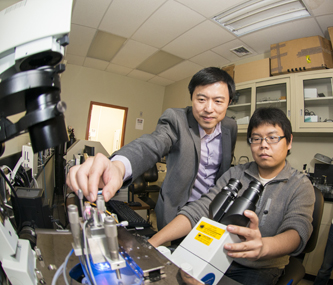Poking information from molecules
Xiaohui (Frank) Zhang, assistant professor of mechanical engineering and mechanics, pokes single molecules and measures the force exerted. Learning how cells sense and respond to mechanical stimuli, he says, could improve the diagnosis and treatment of many diseases.
“The mechanical environment is important in growing organisms,” says Zhang. “If you grow stem cells in a soft environment, you can easily differentiate them into neurons or liver cells, but if you grow them on a hard surface like a petri dish, you can grow bone. Somewhere in between, you grow muscles. This phenomenon is not completely understood.”
Understanding the integrin molecule, which is found in almost every cell in the human body, could help shed light. Zhang’s group uses atomic force microscopy, optical tweezers and a single-molecule force spectroscopic approach to manipulate and measure the mechanical forces exerted on integrin molecules. Their results show that integrin can indeed determine whether a surface is hard or soft.
Single-molecule measurement allows the team to exert minute, controllable forces onto micron-size polystyrene beads held by optical tweezers. They move the tweezers to apply force in various directions. How much force? “About a pico newton,” Zhang says. “That’s about the amount of force ten million people would each have to exert to collectively hold a human hair.”
The group is analyzing how stimuli applied to a cell membrane alter molecular shape and affect biochemical activities inside and outside the cell. They are also exploring how the VWF protein in blood, which stretches out when a living being bleeds and grabs platelets and applies them to the injury, thus beginning the healing process.
If they can learn how integrin becomes a “switch,” as VWF does in blood, Zhang says, it may be possible to develop mechanically switchable devices made of polymer that would be injected into the body, remain inactive until they encounter a disease like cancer, and then release an anti-cancer drug.
The group will also observe how integrin, after being activated by mechanical stimuli, interacts with binding partners like ligands and other proteins. Their hope is that scientists will be able to manipulate integrin function by changing its force-sensing properties, which will help in diagnosing and treating integrin-related illnesses such as cancer, heart disease and multiple sclerosis.
The integrin research is funded by the American Heart Association.
Posted on:



